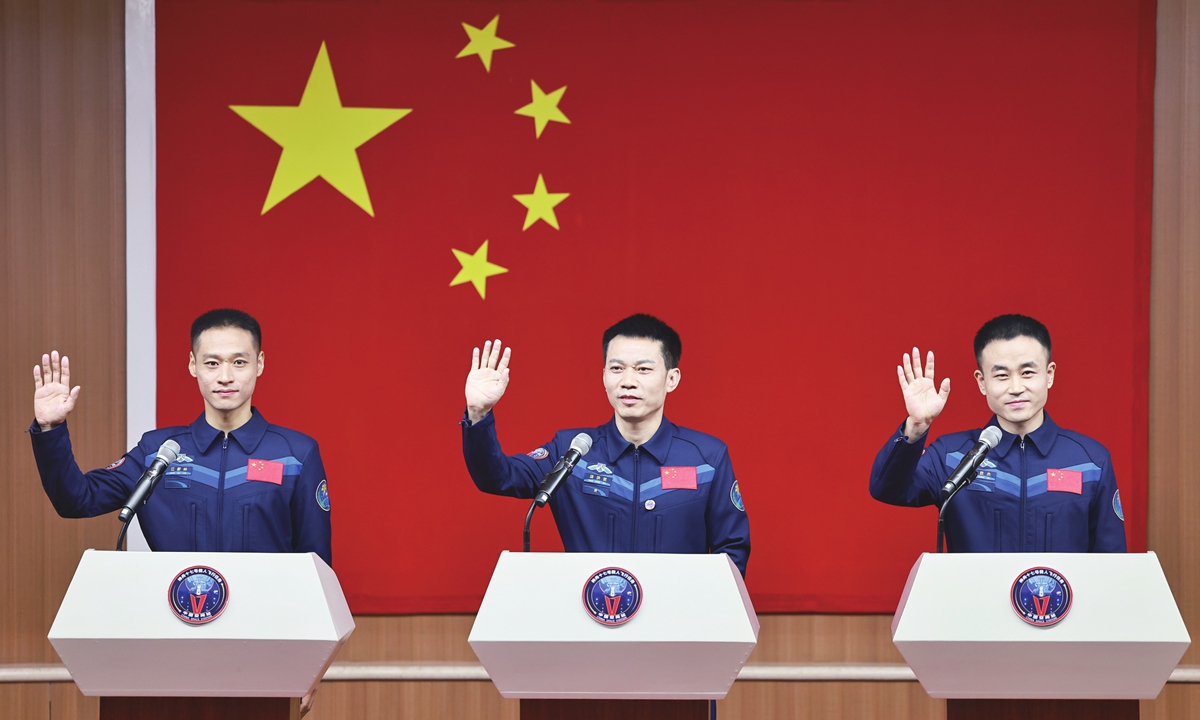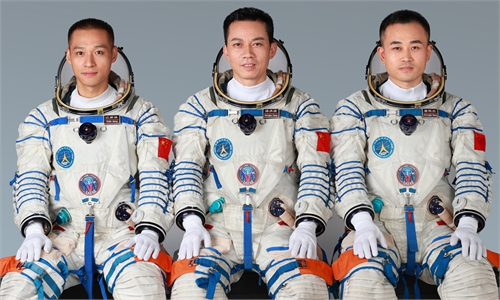China’s Shenzhou-17 mission set to launch and dock
Youngest crew to undertake pioneering space station repair operations

China's Shenzhou-17 mission crew, Jiang Xinlin (left), commander Tang Hongbo (center) and Tang Shengjie, appear at a press conference on October 24, 2023. The mission, which will see Jiang and Tang go to space for the first time, is gearing up for launch on October 25. Photo: Xinhua
China's Shenzhou-17 mission is gearing up for launch on Thursday at 11:14 am, marking the sixth crewed spaceflight to China's Tiangong Space Station and the second mission to the station since the space station entered its development and application stage at the end of 2022.
Veteran mission commander Tang Hongbo, alongside crewmembers Tang Shengjie and Jiang Xinlin, both fresh faces to space, will form the youngest Shenzhou crew since the construction of the Tiangong Space Station.
Tang Hongbo was born in October 1975 and joined the Communist Party of China (CPC) in April 1997. Tang Hongbo was selected as a member of China's second generation of taikonauts in May 2010, and he participated in the Shenzhou-12 crewed flight mission in June 2021. In November of the same year, he was honored with the title of "Heroic Astronaut" by the CPC Central Committee, the State Council, and the Central Military Commission, also receiving the "Third-Class Space Merit Medal," the Global Times learned from the China Manned Space Agency (CMSA) on Wednesday.
Tang Shengjie was born in December 1989 and became a Party member in March 2013. He was selected as a part of China's third batch of taikonauts in September 2020, and following a comprehensive evaluation, he was chosen to be a part of the Shenzhou-17 mission crew, according to the CMSA.
And the third member of the Shenzhou-17 crew, Jiang Xinlin, was born in February 1988 and joined the Party in January 2010. Like Tang Shengjie, Jiang was selected as part of China's third batch of taikonauts in September 2020.
Notably, Tang Hongbo will be the first second-generation taikonaut to lead two younger third-generation taikonauts on a Shenzhou mission. Tang Hongbo will also be the first taikonaut to return to the Tiangong space station with the shortest interval between crewed spaceflight missions to date.
The average age of the Shenzhou-17 mission crew is markedly young at 39.
According to the mission plan detailed by the CMSA on Wednesday, the Shenzhou-17 crewed spacecraft is anticipated to dock with the Tianhe core module of the space station at its front port approximately 6.5 hours after liftoff, forming a three-module three-ship assembly.
The Shenzhou-17 crewed flight mission, set to be the 30th flight mission since the establishment of China's manned space program, and the 12th crewed flight mission, aims at a number of crucial objectives.
The mission's primary goal includes completing the in-orbit crew rotation with Shenzhou-16 trio, before they carry on to conduct an approximate six-month stay in space.
During this period, the crew will engage in in-orbit trials of space science and application payloads, conduct astronaut extravehicular activities, or known as spacewalks, and perform payload extravehicular operations, which according to the CMSA, will also involve the installation of extravehicular payloads and maintenance tasks on the space station.
Moreover, the mission will continually evaluate the functional performance of the space station assembly, accumulating precious data and experience regarding space station operations. This initiative aims to assess the coordination and compatibility of the ground support center in managing space station operational tasks, thereby enriching the operational efficiency and troubleshooting capabilities of the space station, the CMSA said.
The Shenzhou-17 mission represents a significant stride toward enhancing the long-term habitability and operational efficiency of China's space station. Through meticulous planning and execution of the outlined objectives, this mission will contribute to the broader goals of China's manned space program, fostering a deeper understanding of living and working in space, space observers said on Wednesday.
The mission's success will not only mark a new milestone in China's space exploration endeavors but also contribute to the global space community by sharing valuable insights and experiences garnered through extended space habitation and research, they said.
The Shenzhou-17 is expected to remain and work in space until around April 2024, according to Lin Xiqiang, a CMSA spokesperson, on Wednesday. Their processor Shenzhou-16 crew is expected to be coming home on October 31.
A significant highlight of the Shenzhou-17 mission, as revealed by the spokesperson, is the pioneering experimental extravehicular repair operations to be undertaken on the space station. The increasing prevalence of space debris has led to long-term operational spacecraft enduring inevitable impacts from minuscule space particles.
Preliminary inspections have shown minor damage on the space station's solar wings due to multiple impacts from small space particles, Lin said.
With all functions and performance indicators of the space station meeting required standards, the Shenzhou-17 crew will embark on experimental extravehicular repairs through spacewalks, Lin said, noting that such highly challenging task is aimed at elevating the capability and level of extravehicular activities to a new height, ensuring the long-term operational efficacy and technical validation of the space station.
According to the plan, China aims to launch a Xuntian space telescope that will orbit alongside the space station, enabling wide-area patrol observations, according to the CMSA spokesperson.
Lin further elaborated that in the future, China plans to launch additional module segments to transition the basic configuration of the space station from a "T" shape to a "cross" shape.
The planned expansion modules will carry several space science experiment cabinets and external experimental apparatus across various fields, thereby broadening the scope of applications. This expansion aims to cater to the new demands of space science research and applications. Moreover, the upgrade will also encompass enhanced in-orbit protection, dietary, sanitation facilities, and equipment for astronauts, thereby improving the working conditions, living standards, and health safeguards for astronauts aboard the space station, Lin said.
At the Wednesday press conference held in Jiuquan Satellite Launch Center in Northwest China, Lin once again extended official welcome to foreign astronauts, saying that "China is now ready and has made preparations to invite foreign astronauts to participate in flight missions to the Chinese Space Station. China has officially extended an invitation to the global community, welcoming all nations and regions dedicated to the peaceful utilization of outer space to join in the flight missions to the China Space Station."
This gesture symbolizes China's open approach and its aspiration to foster international collaboration in space exploration. By opening its space station doors to astronauts from around the globe, China is looking to create a platform for shared knowledge, technological exchange, and a collective endeavor toward understanding and exploring the cosmos, a space watcher who requested not to be named, shared with the Global Times on Wednesday.



